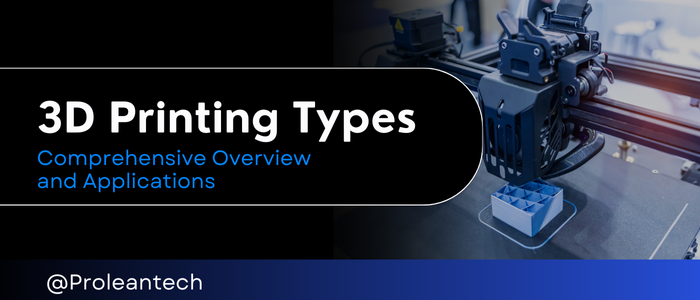
3D Printing Types
3D printing has transformed the world of manufacturing. But have you ever wondered how it produces everything from simple prototypes to complex aerospace parts? Its ability to build intricate and customized designs makes it indispensable in thousands of industries.
Which 3D printing technique is ideal for your use? Let's travel through this amazing world of 3D printing and uncover some of the most applied techniques, such as FDM, SLS, or DMLS printing. Read on to learn how they work and apply this knowledge in real-world environments to improve your projects!
Whether you are an enthusiast, an engineer, or a business owner, this new technology will unlock 3D printing for all its endless possibilities. Let us explore how this new technology is shaping the future of manufacturing and giving you a competitive edge!
3D Printing
3D printing is a family of technologies used for fabricating 3D objects by depositing material layer by layer. Fabricating 3D objects by accumulating layers of material, 3D printing is a family of technologies. Its mode of operation, raw material, and applications vary by technology.
Therefore, understanding the different categories of 3D printing is crucial for selecting the optimal approach for a specific task.
These are some of the 3D printing types mentioned here:
Fused Deposition Modeling (FDM)
FDM printers can be used in many applications, as they can process different materials with different characteristics, such as flexibility, durability, and ease of usage.
Selective Laser Sintering
Selective Laser Sintering (SLS) is the latest additive process that uses high-power lasers to bond tiny ceramics, metals, or polymers of powdered articles. To start the procedure, a slight coating of powder is applied on the build platform.
Direct Metal Laser Sintering
Many metal-based components result from direct metal laser sintering, an advanced 3D printing technology that utilizes powerful lasers to join metal powder to become a solid element.
Stereolithography (SLA)
Stereolithography (SLA) is an old 3D printing technique. It uses ultraviolet laser curation photopolymer resin, which is best for producing components with smooth and fine surface finishing.
The SLA endorses all photopolymer resins and combines them with its composites, which are characterized by strength, transparency, and flexibility.
It is highly demanded by medical modeling and complex prototypes due to its resolution and precision.
The SLA upholds a remarkable resolution ideal for smooth finishes and prototypes.
PolyJet Printing
Polyjet technology forms layers with a curable liquid photopolymer into a build tray, which is hardened by UV light. This type of printing can jet various materials to produce pieces with different materials, textures, and colors.
All types of 3D printing have its pros and cons. You can select the best option by understanding these:
Knowing the different types ensures that you achieve the best results for your specific project!
The applications of 3D printing types are revolutionizing industries around the world. Every area employs various 3D printing techniques to invent and solve problems uniquely.
3D printing is used for faster manufacturing in this industry. FDM benefits in creating quick prototypes that are used for design testing. In SLS, firm and rigid customized tools and fixturing are produced.
DMLS 3D printing services are applied to produce high-grade metal components like those parts of an engine. This technology is also of utmost importance in making lighter-weight electric vehicle parts.
The aerospace industry relies more on SLS and DMLS printing to make lighter, stiffer structural parts, such as brackets and ducts. It utilizes FDM and SLA for prototype preparation before putting the parts through aerodynamic tests. Due to 3D printing, the aerospace sector may make parts on demand, which reduces lead time and saves resources.
3D printing in the medical field gives customized solutions to patients. SLS 3D printing offers prosthetics and implants according to the requirements. While DMLS printing is used for precision surgical tools like implants for dental needs.
There is also 3D printing that makes bioprinting easy so tissues and organs can be produced to serve as transplants. Thus, treatments are becoming affordable and easier to access with 3D printing, revolutionizing health care.
Consumer products manufacturing industries have used 3D printing to create functional and personalized products. Phone covers, eyewear, and footwear are created via FDM. PolyJet technology is used to design a prototype for different materials and color combinations. House utensils and household furniture items are produced by FDM. The technology brings fresh designs to everyday products.
The jewelry industry benefits from the accuracy of 3D printing types. DMLS printing creates intricate designs in metals like gold and silver. SLA and PolyJet printing help test jewelry prototypes before final production. 3D printing also allows jewelers to add custom engravings and unique features to jewelry. This process facilitates the easy creation of personal and complex designs.
The future of this kind of 3D printing looks optimistic as the whole industry continues to progress. Advancements in material, speed, and affordability are here to redefine how 3D printing is used throughout many different industries.
These innovations are propelling 3D printing to growth, making it more versatile, efficient, and, therefore, more essential to industries globally.
1. What is the most affordable type of 3D printing?
FDM is the cheapest, and it is mainly allocated for small-sized and simple prototype projects.
2. How does Selective Laser Sintering (SLS) differ from FDM?
SLS builds parts by sintering powdered material layer on top of layer, which results in better resolution and stronger parts compared to FDM, which builds parts by extruding melted thermoplastic.
3. Can DMLS printing be used for jewelry making?
DMLS is a very advanced technique for manufacturing intricately customized jewelry with metallic materials like gold or titanium.
4. Is 3D printing suitable for mass production?
Prototyping shines in custom manufacturing for 3D printing. But with SLS and DMLS techniques, much has begun to happen at smaller scales.
5. What industries benefit most from DMLS 3D printing services?
DMLS's uses extend into various sectors, including the aerospace, automobile, medical, and jewelry industries.